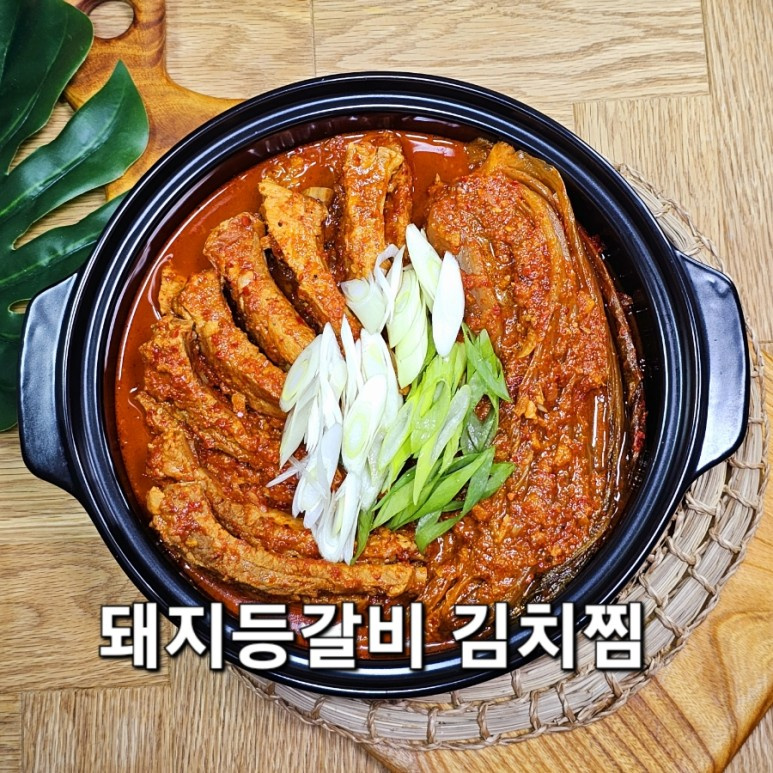Rich & Flavorful Pork Back Rib Kimchi Stew
Pork back rib kimchi stew recipe, aged kimchi pork rib stew, hearty pork rib dish, a deeper flavor than regular kimchi jjigae, rice-thief pork rib kimchi stew

Tender pork back ribs simmered with deeply fermented aged kimchi! Introducing a recipe for Pork Back Rib Kimchi Stew that boasts a rich, festive flavor. This dish is a true rice thief – guaranteed to make you finish your bowl in no time. Let’s get cooking!
Main Ingredients- Pork back ribs 2kg
- Sugar 2 Tbsp (for soaking ribs)
- Bay leaves 5
- Whole peppercorns 10
- White part of green onion, a small piece (for soaking ribs)
- Soju 1/2 cup (for soaking ribs)
- Well-fermented napa cabbage kimchi (aged kimchi) 1/2 head
- Green onion 1 stalk (for garnish)
Seasoning Paste Ingredients- Minced garlic 2 Tbsp
- Ginger paste/syrup 1/2 Tbsp
- Doenjang (soybean paste) 1/2 Tbsp
- Gochujang (red chili paste) 2 Tbsp
- Gochugaru (red chili flakes) 4 Tbsp
- Maesilcheong (plum syrup) 2 Tbsp
- Mirin (or cooking wine) 2 Tbsp
- Ground black pepper, a pinch
- Water (or anchovy-kelp broth) 700ml
- Minced garlic 2 Tbsp
- Ginger paste/syrup 1/2 Tbsp
- Doenjang (soybean paste) 1/2 Tbsp
- Gochujang (red chili paste) 2 Tbsp
- Gochugaru (red chili flakes) 4 Tbsp
- Maesilcheong (plum syrup) 2 Tbsp
- Mirin (or cooking wine) 2 Tbsp
- Ground black pepper, a pinch
- Water (or anchovy-kelp broth) 700ml
Cooking Instructions
Step 1
Rinse the pork back ribs lightly once or twice under cold water. Place the ribs in a bowl, add 2 tablespoons of sugar, and let them soak for about 30 minutes to draw out the blood. Sugar helps in this process.

Step 2
After soaking, rinse the ribs again thoroughly and drain. In a pot, combine the ribs, 5 bay leaves, 10 whole peppercorns, a piece of the white part of a green onion, and 1/2 cup of soju. Add enough water to cover the ribs and bring to a boil. Once boiling, simmer for just 5 minutes. This step helps to remove any gamey odors from the ribs.

Step 3
Drain the blanched ribs and rinse them thoroughly under cold running water. Pay attention to cleaning out any residual bits or impurities between the meat and the bone; using a small brush can help achieve a cleaner result.

Step 4
Prepare the aged kimchi, the star ingredient for the stew. If using a whole head of napa cabbage kimchi, cut it in half crosswise. Feel free to increase the amount if you love kimchi! If adding the kimchi whole feels cumbersome, you can cut it into bite-sized pieces of about 5-6cm length. The sour and sweet notes of the aged kimchi will add depth to the stew.

Step 5
Slice the remaining green onion stalk diagonally. This will be added towards the end for freshness and aroma.

Step 6
Get a deep pot or a wok ready. Arrange the cleaned pork back ribs at the bottom of the pot.

Step 7
Layer the prepared aged kimchi over the pork ribs. The kimchi will absorb the delicious juices from the ribs as it cooks, enhancing the overall flavor.

Step 8
In a separate bowl, combine all the seasoning paste ingredients: minced garlic, ginger paste/syrup, doenjang, gochujang, gochugaru, maesilcheong, mirin, and a pinch of black pepper. Mix well to create a uniform paste. Adding doenjang contributes a savory umami depth to the stew.

Step 9
Spoon the prepared seasoning paste evenly over the pork ribs and kimchi. Ensure it’s spread well so the flavors can penetrate.

Step 10
Carefully pour the 700ml of water (or broth) into the pot, pouring it around the edges. Using broth instead of water will result in an even richer taste.

Step 11
Cover the pot and bring it to a boil over medium-high heat. Once boiling, reduce the heat to medium and let it simmer for about 30 minutes. Check periodically to ensure the liquid isn’t reducing too much.

Step 12
After about 30 minutes of simmering, the pork ribs should be tender, and the kimchi will be soft and fully cooked. You can test the doneness by piercing the ribs with a chopstick; it should go in easily if they are tender.

Step 13
If you cooked this in a wok, you can transfer it to a hot pot or a serving dish once it’s nearly done. This allows you to serve it at the table while keeping it warm throughout the meal.

Step 14
Finally, garnish the stew with the sliced green onions. Let it simmer for another minute or two to allow the fresh onion aroma to meld with the stew. This final simmer helps to slightly thicken the broth.

Step 15
Your delicious Pork Back Rib Kimchi Stew, with its deep and rich flavor, is now complete! Enjoy it with a bowl of hot rice.




